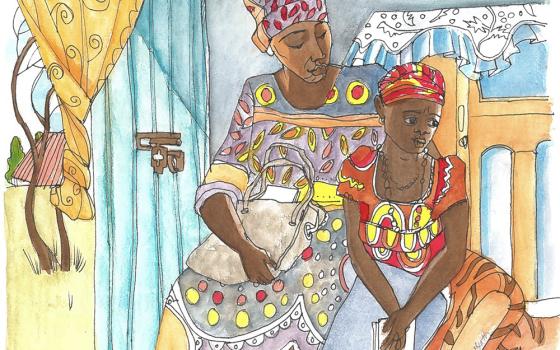During the run up to the Jubilee Year 2000, Pope John Paul asked all local churches “to do everything possible that the memory of those who have suffered martyrdom should be safeguarded” (TertioMillenioAdveniente, 1994) In Edith Stein and Companions on the Way to Auschwitz (Ignatius Press, 2010) author Fr. Paul Hammas has done just this for the Catholic Jews of Holland who were rounded up, sent to Auschwitz, and murdered.
 Edith Stein and Companions on the Way to Auschwitz Edith Stein and Companions on the Way to AuschwitzBy Fr. Paul Hamans Translated from the Dutch by Sr. M. Regina can den Berg, F.S.G.M. Ignatius Press, 2010 |
The Germans invaded and occupied the Netherlands May 10, 1940. On July 11, 1942, a telegram was sent to the Nazi leadership in Holland from ten religious denomination protesting the mistreatment and deportation of the Jews. The Nazis responded by promising that no Jews who had been baptized before 1941 would be deported. This was a surprise because the telegram has been about the abuse of human rights, not special treatment for Christian Jews. On July 20, 1942, the Interdenominational Consultation and the Dutch Catholic bishops headed by Archbishop Jan de Jong, wrote a pastoral letter that was read in all their churches on the following Sunday, July 26. The Catholic letter included the text of the telegram; some Christian churches deleted the telegram as a conciliatory gesture.
Retribution was swift and terrible. More than 400 Catholic Jews were picked up and of these 113 were murdered at Auschwitz.
For the first time Edith Stein and Companions on the Way to Auschwitz offers biographies of 23 of those arrested as well as a list of 83 of those arrested and killed. These persons were arrested Aug. 2, transferred to Amersfoort camp Aug. 4, sent to Auschwitz Aug. 7 and gassed Aug. 9. Sept. 30, 1942 is the last possible date that anyone in this transport could have survived.
The first biography is that of Edith Stein, Sr. Teresa Benedicta of the Cross, and now a canonized saint and her sister, Rosa, a member of the Third Order of Carmel. This is the most extensive chapter because Edith Stein’s writing and career was well documented by herself and others.
Throughout the next twelve chapters the author introduces the reader to a whole new universe of Jewish people who became Catholics, including entire families. Austrian born Ludwig Lob and his wife Johanna van Gelder were baptized Catholic during their engagement. They had six children and died before the Nazi occupation. Five of their children became religious. Their lay sibling was arrested in late August and was sent to Buchenwald. He died in February 1945, shortly before liberation; his brothers and sisters perished in Auschwitz.
The individual stories are fascinating, but the most intriguing is Dominican Sr. Judith Mendez de Costa. Her parents were both of Portuguese-Jewish descent. She became a Catholic at the age of 28 and then entered the Dominicans where she worked as a nurse. After her arrest, she was released because of her Portuguese heritage. It is due to her that this book chronicling that fateful week between Aug. 2 and Aug. 9, 1942, could be documented. Between August 1942 and February 1944 when she was re-arrested she wrote the recollections and letters that support much of the narrative in the book. The picture we get of Sr. Judith is one of joy and courage. According to records, she was gassed in Aushwitz July 7, 1944 (though the exact date is not certain). I would love to have known Sr. Judith.
The Foreword to Edith Stein and Companions on the Way to Auschwitz,is by Ralph McInerny of Notre Dame who says, “Fr. Hamans has put us in his debt for having taken on the enormous task of making [the martyred Catholic Jews] flesh and blood persons….” . His foreword is the only place in the book that deals with the criticism of Pope Pius XII for not speaking out. What happened to the Catholic Jews of the Netherlands, he writes, “is eloquent witness of what could result from public condemnation of the Nazis.” He refers to the Jewish historian Pinchas Lapide who credits “…the leadership of Pius XII with saving the lives of some 860,000 Jews.”
After this comes the introduction and first chapter, titled “Murder of Catholic Jews.” These, while necessary and seek to set the context for events that led up to the Aug. 2 round up, bogged me down in numbers. The details of the telegram of protest and the pastoral letter are essential, but the sequence not as clear as one would hope. It was necessary to return continually to previous pages to keep track of the narrative. I would have to make a chart to see if all the numbers correlated.
The chapters vary in length, depending on how much information was available or could be traced. I found all the stories compelling and heartbreaking. Many photos accompany the text. The translator has added several notes, mostly to clarify geography as many of the Catholic Jews in the book fled to the Netherlands for safety. The appendix is a longer listing of Catholic Jews murdered in response to the pastoral letter of July 26, although incomplete. This list of those from Amsterdam has never been recovered.
The title page says that the book is a translation, but the next page states that the English edition is based on Fr. Hamans original book in Dutch. I called Ignatius Press and asked for clarification. I was told that for the translation both the author and the translator wanted to make changes, perhaps for more clarity. While not a smooth read initially, with Chapter Two, the book takes wings.



